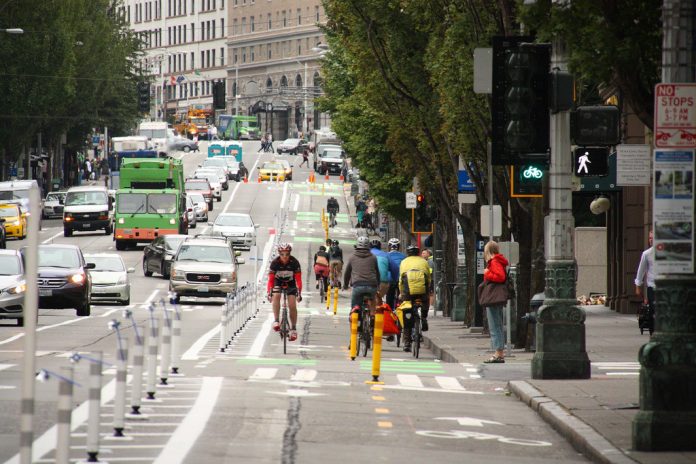Buried amongst the swirling controversies around the Bicycle Master Plan 2019 – 2024 Implementation Plan and major recent bike project cancellations (I’m looking at you 35th Ave NE and Mayor Jenny Durkan) that Seattle transportation advocates and Seattle Department of Transportation (SDOT) employees have been discussing and debating is some of the best news for biking in several years: major growth in ridership.
Bike ridership increased by 12% from 2017 to 2018, based on SDOT’s fixed bike counters at five key locations throughout the city. Ridership on the 2nd Avenue Protected Bike Lane itself is up 32% with the completion of the extension to Denny Way and connections at Pike Street and Pine Street. The 2nd Avenue number is a testimony to the power of building a connected bike network.
As Seattle’s bike lanes grow and connect, it becomes possible to travel safely between more places and ridership grows. This is what was seen in Vancouver after a major expansion of protected bike lanes there, which led to 10% of all commuting being done by bike today, a 60% increase since 2013. And it rains there.
Jim Curtin, Vision Zero program manager for SDOT, said at a recent Move Seattle Levy Oversight Committee meeting that bike ridership numbers increased during the Seattle Squeeze, enough to fill 30 King County Metro buses. And as he went on the say, downtown streets did not have space to accommodate those buses, but it did for people on bikes.
Record numbers of people biking were also seen at points throughout the city. This number is even more amazing given that the city did nothing to encourage bike ridership, squandering an opportunity to reimagine our downtown commuting patterns. The 4th Avenue bike lane was delayed and little effort was made to encourage a mode shift to biking.
As the Move All Seattle Sustainably (MASS) coalition said in a press release issued just before the start of the Seattle Squeeze, “This multi-year traffic crunch should be a catalyst to move rapidly towards the carbon-neutral, multimodal transportation system Seattle needs.”

Fortunately into this void stepped people like Councilmember M. Lorena González, who led by example and started riding a bike from her West Seattle home to city hall, Cascade Bicycle Club who encouraged people to ride with support stations, and folks like my neighbor Robert Getch, a Beacon Hill Safe Streets volunteer who led bike trains from Southeast Seattle to downtown.
We are left to wonder what the number would look like if the city had take the advice of the MASS coalition and used this as an opportunity to roll out additional emergency bike infrastructure (and transit lanes and stepped up pedestrian safety enforcement) and appealed to Seattleites to get out of their cars and onto their bikes. If people are curious about bike commuting, as studies have shown many are, this is the time and the city will support them by increasing safety for riders downtown.
With the completion of NE 65th St and other planned projects such as the Eastlake protected bike lane and the center city bike network, it is easy to see significant portions of the city being connected by all-ages-and-abilities bike lanes in the next few years, and with it biking becoming a safe and climate-friendly option for more people.
My hope is that South Seattle is not left out of this, as the draft bike network implementation plan shows. The City should prioritize safe, all-ages-and-abilities connections to the Rainier Valley, Beacon Hill, Georgetown, South Park, and West Seattle. Right now South Seattle–the most diverse area of the city–is probably the most difficult and dangerous area to bike in the city. Policymakers seem to forgot their racial equity lens when it comes to transportation.
The overwhelming message that has come from these numbers is that as the City has built the bike network, albeit slowly and with major setbacks, the ridership has appeared as predicted. This only strengthens the case for doubling-down on our investments in safe and accessible bike infrastructure. A better, less auto-dependent city is possible, and if we build it, the people will come.
Patrick grew up across the Puget Sound from Seattle and used to skip school to come hang out in the city. He is an designer at a small architecture firm with a strong focus on urban infill housing. He is passionate about design, housing affordability, biking, and what makes cities so magical. He works to advocate for abundant and diverse housing options and for a city that is a joy for people on bikes and foot. He and his family live in the Othello neighborhood.


